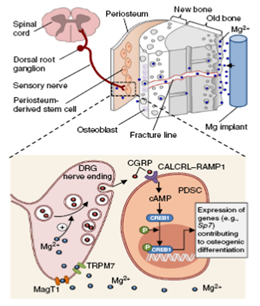Research for the mechanical of implant-derived magnesium on improving bone-fracture healing
Orthopedic implants containing biodegradable magnesium have been used for fracture repair with considerable efficacy; however, the underlying mechanisms by which these implants improve fracture healing remain elusive.
Ling Qin work for The Chinese University of Hong Kong and Shenzhen Institute of Advanced Technology, Chinese Academy of Sciences explore the mechanical of implant-derived magnesium on improving bone-fracture healing. His research groups found the formation of abundant new bone at peripheral cortical sites after intramedullary implantation of a pin containing ultrapure magnesium into the intact distal femur in rats. This response was accompanied by substantial increases of neuronal calcitonin gene-related polypeptide-a (CGRP) in both the peripheral cortex of the femur and the ipsilateral dorsal root ganglia (DRG). Surgical removal of the periosteum, capsaicin denervation of sensory nerves or knockdown in vivo of the CGRP-receptor-encoding genes Calcrl or Ramp1 substantially reversed the magnesium-induced osteogenesis that we observed in this model. Overexpression of these genes, however, enhanced magnesium-induced osteogenesis. We further found that an elevation of extracellular magnesium induces magnesium transporter 1 (MAGT1)-dependent and transient receptor potential cation channel, subfamily M, member 7 (TRPM7)-dependent magnesium entry, as well as an increase in intracellular adenosine triphosphate (ATP) and the accumulation of terminal synaptic vesicles in isolated rat DRG neurons. In isolated rat periosteum-derived stem cells, CGRP induces CALCRL and RAMP1-dependent activation of cAMP-responsive element binding protein 1 (CREB1) and SP7 (also known as Osterix), and thus enhances osteogenic differentiation of these stem cells. Furthermore, we have developed an innovative, magnesium containing intramedullary nail that facilitates femur fracture repair in rats with ovariectomy-induced osteoporosis. Taken together, these findings reveal a previously undefined role of magnesium in promoting CGRP-mediated osteogenic differentiation, suggesting the therapeutic potential of this ion in orthopedics.

Fig 1: Schematic diagram showing diffusion of implant-derived Mg2+ across the bone toward the periosteum that is innervated
by DRG sensory neurons and enriched with PDSCs undergoing osteogenic differentiation into new bone
This work was published in Nature Medicine 22,1160–1169,(2016). doi:10.1038/nm.4162. http://www.nature.com/nm/journal/v22/n10/abs/nm.4162.html